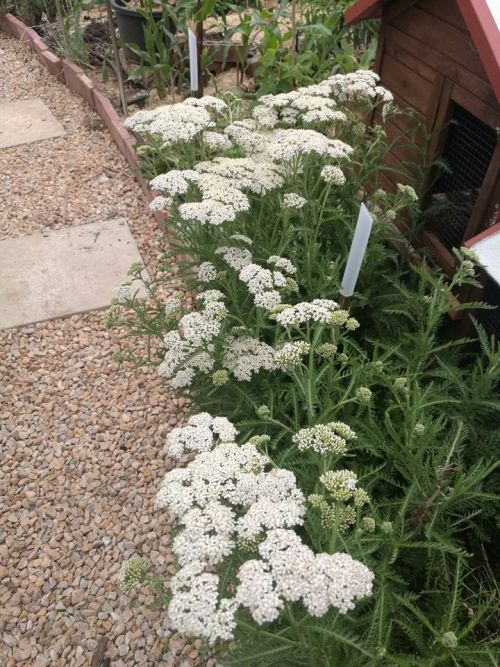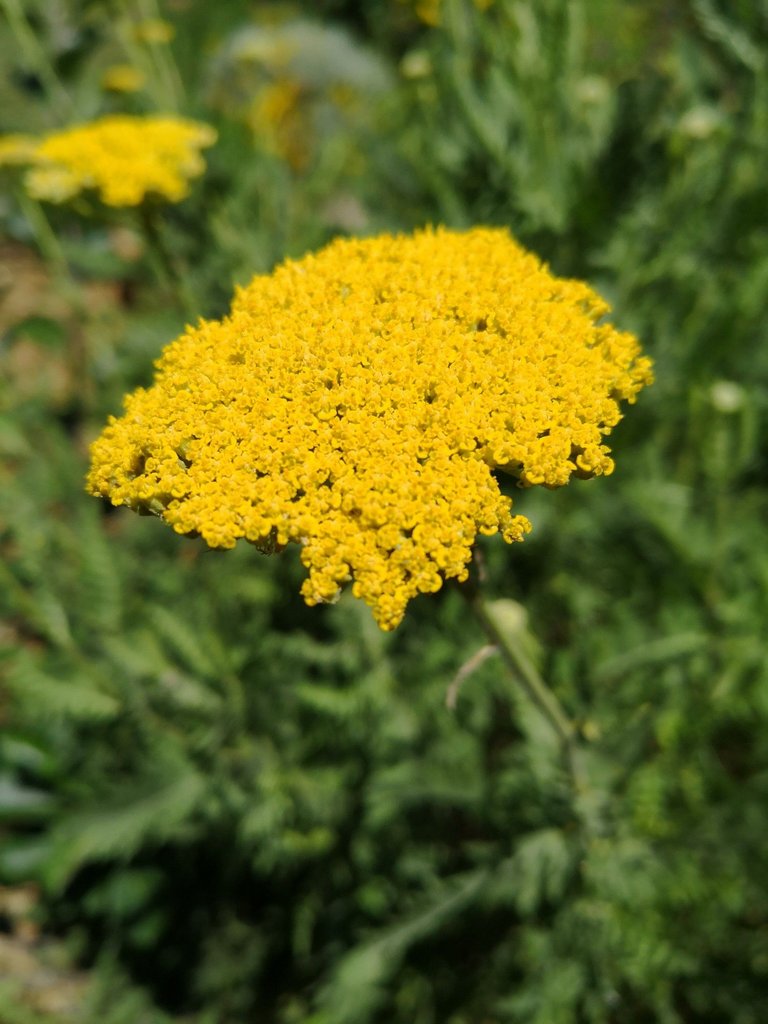
Common names: Yarrow, Common Yarrow, Woundwort, Nosebleed, Belly Ache Weed, Ya Luo, Yang Shi Cao
Taxonomic name: Achillea millefolium
Family: Asteraceae
Related herbs: Chrysanthemums, Daisies
Area of origin: Asia, Europe, North America
Parts used: leaves, flowers, rhizome
Can be used for: Divination, compost, bleeding with bright red blood, fevers, cold and flu, stomach ache, blood pressure, toothaches, nosebleeds,
Organ/System affinities: Small Intestines, uterus, Kidneys, endocrine system, Spleen, Lungs, and pelvic area including bladder and uterus.
Healing Actions: astringent, diaphoretic, digestive stimulant, circulatory stimulant, febrifuge, menstrual system restorative, antispasmodic, antiallergenic, urinary tract antiseptic, emmenagogue, styptic, haemostatic, amphoteric for blood pressure
Taste: sweet, bitter, astringent
Tissue states: heat, damp, relaxation
Energetics: cooling, drying but can be perceived as warming
Healing constituents: volatile oils including chamazulene and proazulenes, alkaloids especially achilleine, isovalerianic acid, salicylic acid, asparagine, sterols, flavonoids, coumarins, tannins, saponins,
Warnings: Yarrow is a uterine stimulant and emmenagogue, so avoid in pregnancy. It can also cause contact skin rashes on some folks and allergic reactions in people with allergies to the Daisy family of plants.
Description
‘Achillea‘ refers to the Greek Hero, Achilles who is reputed to have used this herb on the battlefield to heal the wounds of both his soldiers and his self (though not, apparently, the one that made him famous).
‘Millefolium’ means, literally ‘thousand leaves’. If you take a look at a Yarrow plant, it will appear to have thousands of fern like leaves, each finely cut into many segments that look like more leaves. The leaves seem cut down to the midrib, suggesting the plant’s herbal use for cuts through the Doctrine of Signatures. If you look at the flower head, you might wonder why it isn’t named ‘milleflora‘ because it seems to have thousands of flowers too, raised on an inflorescence. The more traditional, white flowered plant is best for medicinal uses. but here are many other colours cultivated now, from yellow to purple.
Medicinal uses

Yarrow could be our best herb for anything related to blood. It has been called the ‘Master of Blood’ and works well in our Western sense and for Blood in TCM. Yarrow (Achillea millefolium) is as interesting as its botanic name ‘Achillea millefolium‘ suggests. In both schools of medicine, Yarrow both moves the Blood and prevents it from leaking from damaged vessels.
In the list healing actions above, you will see that Yarrow is a styptic, haemostatic, vulnerary and antiseptic – all terms related to staunching the blood and healing wounds. Yarrow has constituents that coagulate proteins, both in the blood and in the damaged tissue that lines the injury. It helps to relax our peripheral blood vessels, moving some of the blood away from the site of the wound and reducing blood flow.
Yarrow excels at those minor arterial cuts that spurt blood. When you see fresh, red blood, think of Yarrow. Crush it up and apply the wad of crushed material directly to the wound and it will help it a lot. Compare this to Shepherd’s Purse which is indicated in wounds that have dark, sluggish, oozing blood. Yarrow is a mild anaesthetic too and acts to relieve some of the pain. That’s why it’s also great for toothache – holding a wad of chewed up leaves or root against the affected area reduces the blood in the area and numbs the site. Yarrow contains salicylic acid, the same pain relieving compound that makes Willow Bark famous.
Moving the Blood helps with menstrual issues, as it eases the flow and relieves congestion, allowing the blood to flow better. It has been applied to the lower abdomen or used as a douche to reduce excessive flow. It really is Master of the Blood. The antispasmodic properties in the plant can help reduce menstrual cramping by relaxing smooth musculature.
Like Elder Flower tea, a couple of hot cups of Yarrow tea will kick up a sweat and help in getting rid of colds and flu. That property is called ‘diaphoretic’ in herbalism. Penelope Ody writes that the flowers are rich in chemicals that, when converted by steam, become anti-allergenic compounds, making Yarrow a great herb to take in cases of allergy and catarrh. This makes Elder and Yarrow a great combination in teas for colds. The same tea can help with internal bleeding (though you should see your GP about that as well).
In Germany, Yarrow is named ‘Bauchwehkraut‘ or ‘Belly Ache Weed’. It has long been indicated for gastrointestinal complaints and digestive disorders. As a diuretic and antimicrobial, Yarrow can help with cystitis and urinary tract infections.
Another interesting use is the one that the Chinese put Yarrow too. Besides being a useful herb, dried Yarrow stalks are used when casting for the I-Ching, a form of divination. Interestingly, European tradition has that if you hold Yarrow against your forehead, it can give second sight.
Yarrow as a garden plant
Sometimes I like to highlight an herb that has a wider range of possibilities that go beyond the herbal. Yarrow is one of those. It is a dynamic accumulator, meaning that it accumulates high levels of certain nutrients within its mass even though those nutrients may be lacking in the soil in which it grows. Yarrow is also a key garden plant because some of the goodies it contains promote the growth of microbes and positively affects other processes in composting, speeding it up and enriching the final product. I used to like I to grow a plant or two, along with Comfrey near to our compost bin so that I could throw a few leaves in when I’m making a batch of compost. Yarrow is an attractant and food source for a wide variety of pollinators and predators. Watch a clump of Yarrow flowers in your garden in the warm weather and you will see a constant buzz of insect activity (pun intended)!
With its nutritional and medicinal properties, Yarrow makes an excellent fodder and first aid plant for livestock. When allowed, they will forage it as they need it.

Preparing and using Yarrow
Yarrow is one of those herbs that can be effectively used in many ways. It shows its real power however when fresh leaves are crushed and applied to fresh wounds – it can heal them remarkably quickly, even deep wounds. In this sense, it’s better than Comfrey because Comfrey can heal the surface aspect of a deep wound while leaving the deeper part unhealed, potentially trapping debris and microbes who will then go to town on the damaged tissue. As a tea or infusion , it can be drunk for many complaints, though drunk hot seems to work better.
The infusion or a decoction can be used as a rinse or a gargle for many mouth, gum and upper respiratory tract complaints. Externally it can be used to wash wounds, rashes and irritations. Breathing the fumes from a strong, hot brew can relieve stubborn congestion in the nasal area.
Applying the decoction as a compress or fomentation can directly relieve a range of the complaints listed above.
I have made a healing salve that combines the wound healing potential of both Calendula and Yarrow oils plus beeswax. Both herbs can heal wounds but the Calendula makes the Yarrow a bit milder and also helps reduce any scarring that may occur during healing.
Yarrow tincture is quite potent, I recommend tincturing it in strong alcohol (>50%) to extract that potent aromatic oil . Use the tincture sparingly, it is quite potent and I’d recommend starting it with a dose of 10 or so drops at a time. The tincture can also be diluted and used as a wash for fresh wounds. I find than when dropping a little Yarrow tincture onto my tongue, my whole body seems to shift and I can feel energy moving to the periphery of my body. I’ve not noticed any other herb act that strongly.
Rubbing Yarrow on the skin can help repel insects.
Some of you may have seen that I've been writing a series of posts about herbs and making herbal remedies at home. I want to share what I know of this topic so that, as the world gets crazier, folks will have other avenues of medical care, namely those of themselves and their community. If you look back over this blog, you can see heaps of info on the topic, plus loads and loads of posts on herbs and using Australian bushfoods from a white perspective. If you haven't been around on in the @hivegarden and @naturalmedicine communities for long, you may be interested in looking back. There's w-a-a-a-a-y too much there for me to repost and the Hive system doesn't let you vote on old posts so, if you're happy with what you find, I believe that there is now a tip option...




